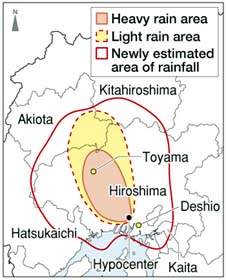Black rain
Aug. 24, 2012
Radioactive materials fell with the rain
After the atomic bomb exploded, a huge mushroom cloud formed in the sky above the city of Hiroshima. Twenty to thirty minutes later, "black rain" began to fall. This dark-colored rain contained dust stirred up by the blast, soot from the roaring fires produced by the bomb’s heat rays, and radioactive materials emitted by the bomb.
In 1976, prompted by research conducted in the years since the bombing, the Japanese government designated the area of heavy black rainfall as the "heavy rain area." Those who were exposed to the black rain in this area are able to receive free health checkups. And in the event they develop certain diseases, such as cancer, they are eligible to obtain the Atomic Bomb Survivor's Certificate. The area of "light rain," however, is excluded from these support measures.
A survey that has been carried out by the Hiroshima city government and Hiroshima prefectural government, since 2008, has revealed that the black rain actually fell in an area about six times larger than the current "heavy rain area," and that those who were exposed to the black rain are worried about their health. The local Hiroshima governments have called on the central government to designate the entire area, including the "light rain area," as an area eligible for special support measures. The central government is now conducting its own scientific assessment of this claim.








